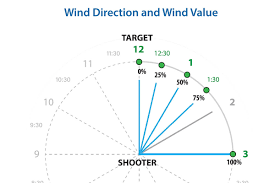How does the optic play into the compensation calculations?
Wind is the hardest thing to gauge with shooting as it is the fastest variable to change and is often different day after day as well as changing around landmarks.
A Kestrel is the best way to measure wind speed and direction at the firing point and it will be the primary information which you will put into your ballistics calculator.
Enter this information into your ballistics calculator (Applied ballistics, Hornady, etc) and take note of the values it gives you for these distances.
If you don't have a kestrel to measure the wind speed and direction, there are rough measurements for what the surrounding environment will be doing at certain wind speeds.
* Weak: 1-3mph. Smoke/powder indicates, grass moves slightly, as do leaves.
* Medium: 4-7mph. Wind felt on face, leaves rustle and sway.
* Strong: 8-12 mph. Smaller treetops and bushes sway back and forth.
* Very strong: 13-20mph. Whipping trees and shrubs move rapidly back and forth. It’s likely that unless absolutely constant, one would not attempt a shot at long-range.
Wind direction will still need to be assessed for this but that can be roughly measured by picking up some dust or loose grass and dropping them from head height.
This is obviously a less accurate method of measuring wind speed and direction but it can give you a good starting point. Think of the bullet as a weathervane pointed at the target. A head wind keeps the bullet pointing forward, whereas a side wind, it causes the bullet to point off centre giving an impact to the left or right of the centre. A 10-mph head wind has no effect on the horizontal movement and while wind hitting squarely on the side will have the greatest effect. Anything in between will have a proportionately smaller effect. This is why it’s important to know the wind direction.
Sometimes you won’t have access to a ballistic solver and will need to rely on your own knowledge and a dope card. Your dope card includes elevation and wind holds. For example, let’s say your rifle’s wind hold for a 12-mph crosswind at 600 yards is 1.2 MILs. If you're facing a headwind, it has little to no effect, so you can aim directly at the centre of the target without adjusting for wind.
For a full left or right wind, you'd apply the full 1.2 MILs hold. But if the wind is coming from the 1 o’clock direction, picture yourself standing on a clock face. A 1 o’clock wind is at an angle and only has about 50% of the effect of a full-value crosswind. So, you'd cut the wind speed in half—12 mph becomes 6 mph—and check your wind table for the new hold. In this case, that would be 0.6 MILs.
There are two other key wind angles to know:
-
Between 12 and 1 o’clock (or 11 and 12) is a 25% value wind
-
Between 1 and 2 o’clock (or 10 and 11) is a 75% value wind
Knowing these fractional wind values helps you make accurate holds without needing a calculator in the field.

For wind down range, take note of the direction as this could affect the trajectory of your shot.
If the wind is consistent all the way to the target, then the ballistics data will hold true.
However, if it is not consistent then it could affect the ballistics data especially at very long ranges.
The best way to mitigate this is to hold for the wind to die down before taking the shot.
Alternatively getting closer will help reduce the effect of this changing wind.
Optics
Using the rifle scopes reticle for wind is a generally simple process.
On most target rifle scopes, there are subtensions (hash marks) on the horizontal line in which you can use for a wind hold.
For example, imagine you need to make a shot on a deer but the wind is blowing from right to left and you need to hold 2MIL.

You would hold 2MIL into the wind so that the winds effect will push the shot back onto the intended point of impact.
If the wind is moving to the right, you need to aim left.
If the wind is moving to the left, you need to aim right.
Summary
With all this information in mind, it's important to remember that if you accurately give the wind into the ballistics calculator, the calculator will give you accurate information.
If you guess the wind, you guess the shot.
A ballistic chart or DOPE sheet makes a large difference when it comes to these calculations but knowing how to adapt the information to changing conditions will make the difference to a shot hit and a shot missed.
